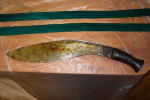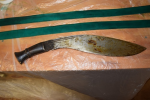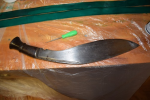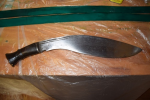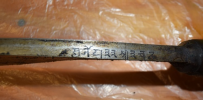Talking with a friend of mine that is into collecting knives, he recommended that I polish up the Kukri, which is definitely NOT going to happen

Anyhow, he strictly owns modern knives, not owning anything over maybe 20 years old. So, I can see why he thinks my old Kukri knife may look a bit ugly, (in his eyes).
I do wonder how many of these old Kukri knives will be going through what most antique collectors would consider as too much cleaning, or even full blown modification.
My friend and I spoke about cleaning such old things, and I again stressed that my Kukri only needed to have it's old grease removed, and that it entailed no abrasives or tools of any sort whatsoever.
Further into the conversation, he wondered when or if I would ever consider using abrasives or tools on an old knife. I had to think about that for a moment. Then my response, (right or wrong), was given. I told him yes, but only under certain circumstances.
If an old blade, (or any blade), had active red rust, then I know that it continues to be hurting the steel, and I would want it stopped. Even so, I would only go as far as needed to achieve this, not go full blown "let's go bling bling on it" mode.
We talked about the old pits and gray look of the Kukri I have, and I told him they looked great in my eyes. Also, the knife kept clean, lightly oiled, and in stable air quality, it would remain in it's current condition indefinitely.
It's amazing how I too, when I was a younger man, would have looked at this Kukri and thought to myself... "I can restore this thing to look almost new".
I am so glad my brain has evolved into not thinking like that now, or I would have destroyed the totally awesome appearance of this item by listening to my friend's advice to break out with the sandpaper, polishing compounds, and buffing wheels on an electric tool.
Again, I know that the purchase of the Royal Nepalese Armoury contents in 2003 was an act that likely saved those items from full decay. And, that the armory was actually destroyed somewhat recently by that terrible earthquake they had in Nepal. But, with that said, I also do wonder how many of these items will be treated as fodder to just play around with. As items purchased for major invasive cleaning or full blown restorations.
So, while many of these Kukri knives will remain as rescued items from an old armory that was no longer the safe haven for them that it may have once been... I do wonder how many have/will wind up in the hands of folks that think like my friend, or think the way I myself used to think, and "clean them" or "modify them" to the point of destroying their antique condition.
Please don't get me wrong... I believe when you buy an item, it's yours to do, or not do, as you please with it.
But, that said, I also see it a shame, (imo), to see an item that holds such historic teachings, be tampered with too much for reasons of posterity.
I am hoping that maybe folks stumbling onto this thread that wind up buying one of these Kukri knives, maybe thinks twice about "restoring" their aquisition



